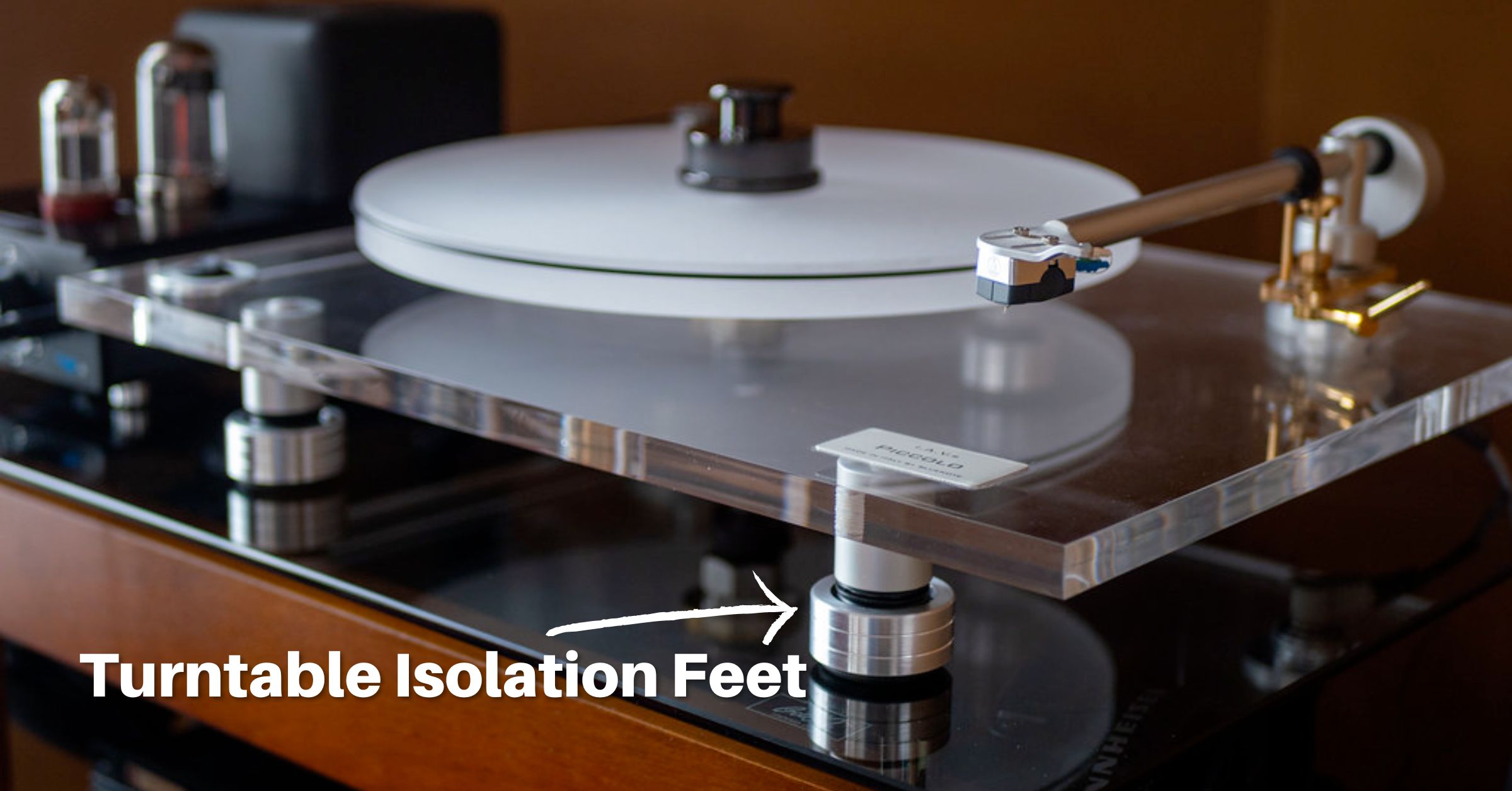Picture this: you’re sitting back, listening to one of your favorite records. You’re so encapsulated by the music that you almost don’t notice your roommate coming down the stairs. Before you can warn them, it’s too late. Your roommate stomps by and you cringe as your needle bounces across your record.
If this scenario or something like it is a regular occurrence for you, it might be time to invest in some turntable isolation feet.
In this article, we discuss why turntable feet are a good first step in overall turntable isolation, which protects your precious records from heavy-footed roommates, spouses, or siblings.
What are turntable isolation feet?
For those unaware, turntable isolation feet are small discs that can be placed under a turntable to absorb vibration. These discs are usually made of rubber or springs loaded. This reduces the chances that vibrations will make their way to the turntable needle and cause the record to skip.
Turntable feet come in all shapes and sizes, and sometimes turntables come pre-installed with them. To test this, lightly press down on your turntable. Does the turntable sink in response to the added pressure? If so, your turntable might already have isolation feet.
The importance of turntable isolation
Proper turntable isolation is essential to getting the most out of your records as well as protecting them. While we won’t cover isolation in full, we do have a full article covering the concept you can read here.
Just know this: Isolation reduces the chances that vibrations from the surrounding environment make their way up to your turntable and ultimate the turntable stylus. The only vibrations that should be read by the stylus are from the record itself. Any outside factors can cause distortion – and if they’re big enough vibrations – skipping and damage.
Signs you need turntable isolation feet
Here are a few signs often associated with turntable isolation that proper turntable feet can help prevent.
You have hardwood floors
Hardwood floor is notorious in vinyl communities for being overly “bouncy,” which in turn sends a vibration through the floor, up to your turntable. Since you can’t exactly change your floors very easily, turntable isolation feet can be a way to absorb the vibration before it makes its way to the record needle.
You’re in a confined space
While some vibration issues can be solved by adjusting the location of your turntable to move it away from the wall or speakers, sometimes that isn’t always an option if your setup is in a bedroom or office.
Adding turntable feet will help enhance the sound of your setup without having to rearrange the house to accommodate for minor vibrations.
You’re noticing consistent skipping on multiple records
While not always a sign of vibration issues, if you’re experiencing skipping on multiple records, and that skipping is associated with movement in the room, odds are you need to isolate your turntable more.
Your turntable has no isolation feet or the feet are old
If your turntable has no feet underneath them, or the feet that have are old and worn, it’s probably a good idea to start considering some isolation feet or replacement turntable feet.
Types of turntable feet
Turntable isolation feet come in a variety of shapes and sizes, and not all of them are branded just for turntables.
Rubber turntable feet
Rubber turntable isolation feet are some of the most standard and cost-effective designs you can come by. This design is specifically meant to isolate the turntable from vibrations.
Spike turntable feet
Spiked turntable feet are another design often used on turntables. The idea behind spiked feet is to minimize contact with the supporting surface to reduce interference. Spiked feet tend to tune certain frequencies coming from the turntable as opposed to isolating.
Spiked feet work best when paired with another form of isolation such as a wall-mounted shelf. This allows the turntable to produce enhanced sound without worrying about reducing vibrations, though these feet would still be effective in doing that.
Spring turntable feet
Spring turntable isolation feet are meant to be a more intense method of isolation than rubber feet. This is because springs offer more absorption than just rubber. The general idea is that if larger vibrations come through, the springs will absorb most of the energy before anything can damage your turntable needle. The same principle can be seen in a car’s suspension system.
Isolation pads
Isolation pads can be used on their own or with spiked or rubber feet. They are flat pieces of metal, wood, or cork that sit on a flat surface. Then turntable feet are then placed on top of them for an additional layer of isolation.
Spikes vs. rubber turntable feet
There are a lot of questions about if spikes or rubber feet are better for turntables. The answer is subjective, but generally, if your setup is well isolated, spikes are typically going to be the better option for overall sound quality enhancement.
Let’s think about it: Rubber offers great vibration deadening. Yes, this helps reduce external vibrations from around the room such as footfalls or doors closing, but it also reduces resonate frequencies coming from the turntable plinth. For high-end turntables, this can deaden the sound and reduce dynamics.
It’s like putting a piece of cloth on an acoustic guitar. If there’s buzzing, it might reduce that, but at the expense of the overall dynamics of the music.
Spikes, on the other hand, concentrate all the weight onto four hard and fine points. While this does provide less isolation from vibration, it allows the turntable to “breathe” more.
This can be a good thing or a bad thing depending on the turntable. Sometimes spiked replacement turntable feet can be too much of a departure from how the turntable was originally designed and cause certain resonant frequencies to be amplified.
Final thoughts about turntable isolation feet
At this point, you have all the information you need to aid your search for the right turntable isolation feet. We hope you found this guide helpful. Thanks for reading!

Lead Editor / Owner
After beginning his career in the video and audio recording industry, Andrew started HiFi Hippo to share his knowledge and passion for vinyl and vintage audio with other readers.
